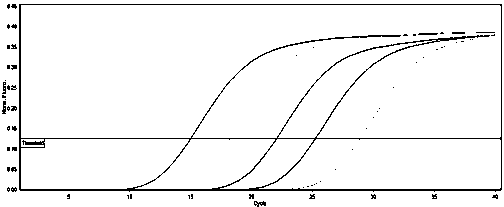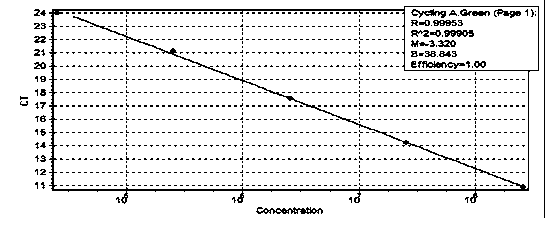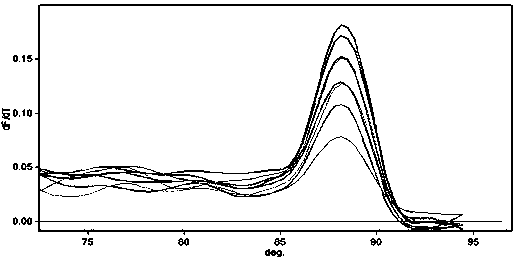Method for detecting quantity of pseudomonas fluorescent in rhizospheric soil during growth period of transgenic wheat by virtue of fluorescent quantitative PCR (Polymerase Chain Reaction)
A technology of Pseudomonas fluorescens and transgenic wheat, applied in fluorescence/phosphorescence, biochemical equipment and methods, microbial measurement/inspection, etc., can solve problems such as no revelation, and achieve simple identification methods and high amplification efficiency , good specific effect
- Summary
- Abstract
- Description
- Claims
- Application Information
AI Technical Summary
Problems solved by technology
Method used
Image
Examples
Embodiment 1
[0026] Embodiment 1: The establishment of fluorescent quantitative PCR system
[0027] (1) Preparation of Pseudomonas fluorescens DNA template required for making a standard curve
[0028] According to Pseudomonas fluorescens gyrB Gene and fluorescent quantitative PCR primers require primer design:
[0029] SEQ ID No. 1: gyrB-F: TGTTCGAGGTGGTCGACAACT
[0030] SEQ ID No.2: gyrB-R: TGGAGGACGGTCATGATGA
[0031] Use this primer to amplify the target fragment from the extracted soil total DNA. The PCR reaction body is 25 μL, including 0.125 μL of rTaq enzyme, 2.5 μL of 10×PCR buffer, 2 μL of dNTP, 1.5 μL of Mgcl, 1 μL of upstream and downstream primers (10 μmol / L), 1 μL of template, and deionized water to make up the volume. The reaction conditions are: pre-denaturation at 94°C; denaturation at 94°C, annealing at 55°C, extension at 72°C, 35 cycles; agarose gel electrophoresis after 10 minutes of extension to confirm whether the PCR product is single and specific, and if the...
Embodiment 2
[0042] Embodiment 2: Sensitivity detection of fluorescent quantitative PCR detection system
[0043] The constructed standard plasmid was diluted 10 times to 2.57×10 10 Copies / μL~2.57×10 copies / μL, use the corresponding primers for fluorescent quantitative amplification to test the sensitivity of the amplification. Amplification curves were obtained (see attached Figure 4 ), and the amplification results were detected by agarose gel electrophoresis (see attached Figure 5 )
[0044] From the analysis of the above results, it can be known that after carrying out 10 times to the standard plasmid -7 Before double dilution, the amplification curve still showed an "s" shape, and the amplification curve was evenly spaced, and it also showed a clear gradient and better brightness after agarose gel electrophoresis. -7 After dilution, the "s" type of the amplification curve is not obvious, and the gradient cannot be distinguished. At this time, the sensitivity decreases, which is...
Embodiment 3
[0046] Analysis on the growth dynamics of Pseudomonas fluorescens in the rhizosphere soil during the main growth period of transgenic wheat
[0047] Adopt the fluorescent quantitative PCR system of embodiment 1
[0048] The real-time fluorescent quantitative PCR instrument was carried out by Rotor Gene 6000 fluorescent quantitative PCR produced by Corbett Company (Australia).
[0049] Collect wheat rhizosphere soil at the same place at the sowing stage, jointing stage, filling stage and maturity stage of winter wheat growth respectively, extract DNA, use the specific primers and amplification system provided in Example 1 to amplify, and calculate according to the standard curve Obtain the initial Pseudomonas fluorescens count in the soil sample.
[0050] The number of Pseudomonas fluorescens in the rhizosphere soil of wheat throughout the growth period was detected using the established Real-Time QPCR (see appendix Image 6 ). 2012 turn WYMV-Nib8 The copy number of Pseudo...
PUM
| Property | Measurement | Unit |
|---|---|---|
| correlation coefficient | aaaaa | aaaaa |
Abstract
Description
Claims
Application Information
 Login to View More
Login to View More - R&D
- Intellectual Property
- Life Sciences
- Materials
- Tech Scout
- Unparalleled Data Quality
- Higher Quality Content
- 60% Fewer Hallucinations
Browse by: Latest US Patents, China's latest patents, Technical Efficacy Thesaurus, Application Domain, Technology Topic, Popular Technical Reports.
© 2025 PatSnap. All rights reserved.Legal|Privacy policy|Modern Slavery Act Transparency Statement|Sitemap|About US| Contact US: help@patsnap.com



